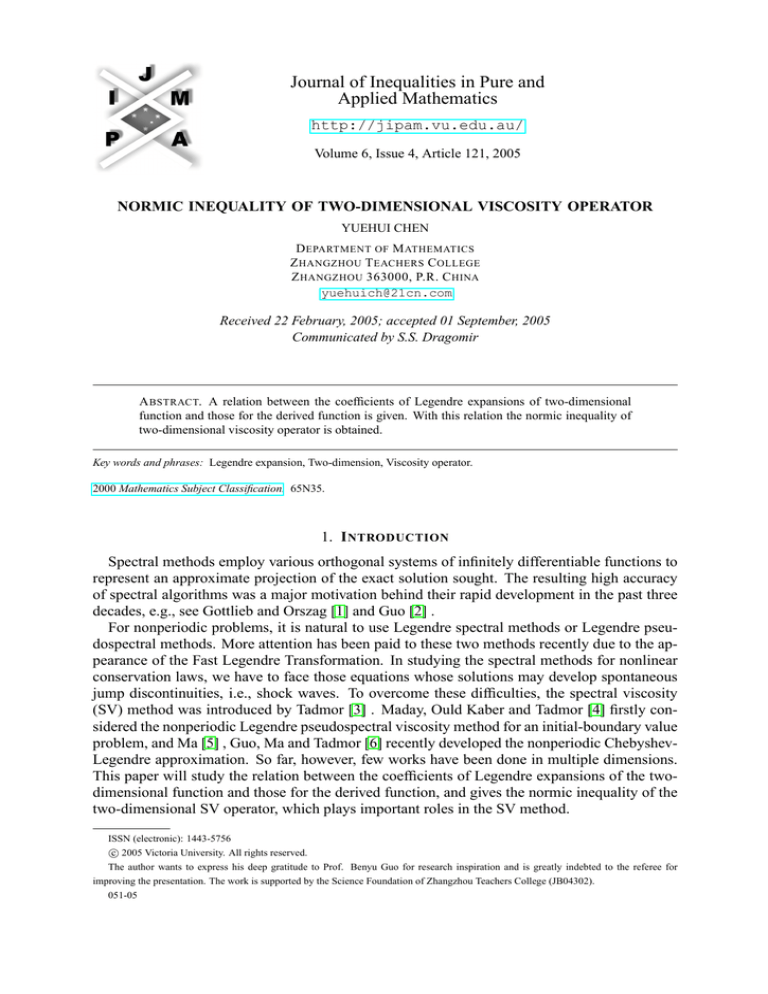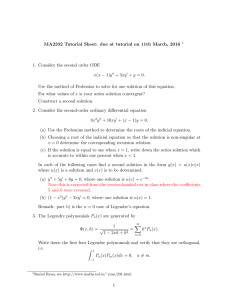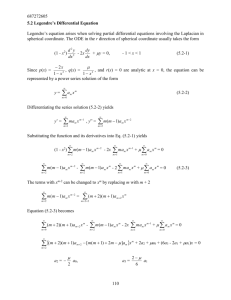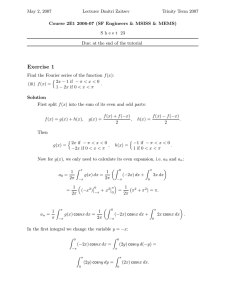
Journal of Inequalities in Pure and
Applied Mathematics
http://jipam.vu.edu.au/
Volume 6, Issue 4, Article 121, 2005
NORMIC INEQUALITY OF TWO-DIMENSIONAL VISCOSITY OPERATOR
YUEHUI CHEN
D EPARTMENT OF M ATHEMATICS
Z HANGZHOU T EACHERS C OLLEGE
Z HANGZHOU 363000, P.R. C HINA
yuehuich@21cn.com
Received 22 February, 2005; accepted 01 September, 2005
Communicated by S.S. Dragomir
A BSTRACT. A relation between the coefficients of Legendre expansions of two-dimensional
function and those for the derived function is given. With this relation the normic inequality of
two-dimensional viscosity operator is obtained.
Key words and phrases: Legendre expansion, Two-dimension, Viscosity operator.
2000 Mathematics Subject Classification. 65N35.
1. I NTRODUCTION
Spectral methods employ various orthogonal systems of infinitely differentiable functions to
represent an approximate projection of the exact solution sought. The resulting high accuracy
of spectral algorithms was a major motivation behind their rapid development in the past three
decades, e.g., see Gottlieb and Orszag [1] and Guo [2] .
For nonperiodic problems, it is natural to use Legendre spectral methods or Legendre pseudospectral methods. More attention has been paid to these two methods recently due to the appearance of the Fast Legendre Transformation. In studying the spectral methods for nonlinear
conservation laws, we have to face those equations whose solutions may develop spontaneous
jump discontinuities, i.e., shock waves. To overcome these difficulties, the spectral viscosity
(SV) method was introduced by Tadmor [3] . Maday, Ould Kaber and Tadmor [4] firstly considered the nonperiodic Legendre pseudospectral viscosity method for an initial-boundary value
problem, and Ma [5] , Guo, Ma and Tadmor [6] recently developed the nonperiodic ChebyshevLegendre approximation. So far, however, few works have been done in multiple dimensions.
This paper will study the relation between the coefficients of Legendre expansions of the twodimensional function and those for the derived function, and gives the normic inequality of the
two-dimensional SV operator, which plays important roles in the SV method.
ISSN (electronic): 1443-5756
c 2005 Victoria University. All rights reserved.
The author wants to express his deep gratitude to Prof. Benyu Guo for research inspiration and is greatly indebted to the referee for
improving the presentation. The work is supported by the Science Foundation of Zhangzhou Teachers College (JB04302).
051-05
2
Y UEHUI C HEN
2. N OTATIONS AND L EMMAS
Let x = (x1 , x2 ), Λ = (−1, 1)2 . We define the space Lp (Λ) and its norm k · kLp in the usual
way. If p = 2, we denote the norm of space L2 (Λ) by k · k, that is
Z
12
2
kvk =
|v(x)| dx .
Λ
Let N be the set of all non-negative integers and PN be the set of all algebraic polynomials
of degree at most N in all variables. Let l = (l1 , l2 ) ∈ N 2 , |l| = max{l1 , l2 }, the Legendre
polynomial of degree l is Ll (x) = Ll1 (x1 )Ll2 (x2 ). The Legndre transformation of a function
v ∈ L2 (Λ) is
∞
X
v̂l Ll (x),
Sv(x) =
|l|=0
with the Legendre coefficients
Z
1
1
v̂l = l1 +
l2 +
v(x)Ll (x)dx,
2
2
Λ
|l| = 0, 1, . . . .
Lemma 2.1 ([2]). For any φ ∈ PN , 2 ≤ p ≤ ∞ and |k| = m, we have
k∂xk φkLp ≤ cN 2m kφkLp .
Here, c is a generic positive constant independent of any function and N .
A viscosity operator Q is defined by
(2.1)
Qv(x) :=
N
X
q̂l v̂l Ll (x),
|l|=0
v̂l Ll (x).
|l|=0
Here, q̂l are the so-called viscosity coefficients,
for
q̂l = 0
q̂l ≥ 1 −
v=
∞
X
m2
l12 +l22
for
|l| ≤ m
m < |l| ≤ N.
Observe that the Q operator is activated by only the high mode numbers, ≥ m. In particular, if
we let m −→ ∞, the Q operator is spectrally small (in the sense that kQvkH −s ≤ cm−s kvk).
Let R denote the corresponding low modes filter
(2.2)
Rv(x) :=
N
X
r̂l v̂l Ll (x),
here r̂l = 1 − q̂l .
|l|=0
Clearly,
r̂l = 1
r̂l ≤
for |l| ≤ m
m2
l12 +l22
for m < |l| ≤ N.
3. M AIN R ESULTS
Firstly , we consider the relation between the coefficients of Legendre expansions of v(x)
and those for ∂x v(x).
J. Inequal. Pure and Appl. Math., 6(4) Art. 121, 2005
http://jipam.vu.edu.au/
N ORMIC I NEQUALITY
OF
T WO -D IMENSIONAL V ISCOSITY O PERATOR
3
(1)
Theorem 3.1. For any v(x) ∈ H 1 (Λ), let v̂k , v̂k be the coefficients of Legendre expansions of
v(x), ∂x v(x), |k| = 0, 1, 2, . . . ,
∞
∞
X
X
(1)
(1)
v̂k = v̂(k1 ,k2 ) = (2k1 + 1)
v̂(p,k2 ) + (2k2 + 1)
v̂(k1 ,q) .
p=k1 +1
k1 +p odd
q=k2 +1
k2 +q odd
Proof. By the property of the one-dimensional Legendre polynomial:
(2k + 1)Lk (x) = L0k+1 (x) − L0k−1 (x),
we have
L0k (x)
=
k−1
X
(2l + 1)Ll (x),
k ≥ 1,
k = 0, 1, 2, . . . .
l=0
k+l odd
Then, for x = (x1 , x2 ),
∂x Lk (x) = L0k1 (x1 )Lk2 (x2 ) + Lk1 (x1 )L0k2 (x2 )
=
kX
1 −1
(2l1 + 1)Ll1 (x1 )Lk2 (x2 ) +
l1 =0
k1 +l1 odd
∂x v =
∞
X
kX
2 −1
(2l2 + 1)Ll2 (x2 )Lk1 (x1 );
l2 =0
k2 +l2 odd
v̂k ∂x Lk (x)
|k|=0
=
∞
X
∞
X
k1 −1
X
(2l1 + 1)Ll1 (x1 )Lk2 (x2 )
v̂(k1 ,k2 )
l1 =0
k1 +l1 odd
k1 =0 k2 =0
kX
2 −1
+
(2l2 + 1)Ll2 (x2 )Lk1 (x1 ) .
l2 =0
k2 +l2 odd
On the other hand,
∂x v =
∞
X
(1)
v̂k Lk (x)
=
|k|=0
∞ X
∞
X
(1)
v̂(k1 ,k2 ) Lk1 (x1 )Lk2 (x2 ).
k1 =0 k2 =0
We can obtain
(1)
v̂(k1 ,k2 )
= (2k1 + 1)
∞
X
v̂(p,k2 ) + (2k2 + 1)
p=k1 +1
k1 +p odd
∞
X
v̂(k1 ,q) .
q=k2 +1
k2 +q odd
Specially, for any v ∈ PN , we have
(3.1)
(1)
v̂(k1 ,k2 )
= (2k1 + 1)
N
X
v̂(p,k2 ) + (2k2 + 1)
p=k1 +1
k1 +p odd
N
X
Let Jk,N = {j k + 1 ≤ j ≤ N, k + j odd}, then
X
X
(1)
v̂(k1 ,k2 ) = (2k1 + 1)
v̂(p,k2 ) + (2k2 + 1)
v̂(k1 ,q)
p∈Jk1 ,N
J. Inequal. Pure and Appl. Math., 6(4) Art. 121, 2005
v̂(k1 ,q) .
q=k2 +1
k2 +q odd
∀ v ∈ PN
q∈Jk2 ,N
http://jipam.vu.edu.au/
4
Y UEHUI C HEN
Theorem 3.2. Consider the SV operator Q = Qm , (2.1) with the parametrization and operator
R, (2.2). For any φ ∈ PN , the following inequalities hold:
k∂x (Rφ)k2 ≤ cm4 ln N kφk2
k∂x φk2 ≤ 2k∂x (Qφ)k2 + cm4 ln N kφk2
k∂x (Qφ)k2 ≤ 2k∂x φk2 + cm4 ln N kφk2
Proof. We decompose ∂x (Rφ(x)) = A1 (x) + A2 (x), where
A1 (x) := ∂x
m
X
r̂k φ̂k Lk (x) ,
A2 (x) := ∂x
|k|=0
N
X
r̂k φ̂k Lk (x) .
|k|=m+1
By Lemma , k∂x φk ≤ cN 2 kφk, ∀ φ(x) ∈ PN , and hence kA1 (x)k2 ≤ cm4 kφk2 .
(d)
(0)
Further let Jk,N = {j j ∈ Jk,N , j > m}, Jk,N = {j j ∈ Jk,N , max{j, kd } > m}, here,
m ∈ N , d = 1, 2. Then
2
kA2 (x)k2 ≤
N
X
X
X
φ̂
+
(2k
+
1)
r̂(k1 ,q) φ̂(k1 ,q) kLk k2
(2k
+
1)
r̂
1
2
(p,k2 ) (p,k2 )
|k|=0
(1)
2 ,N
(2)
1 ,N
q∈Jk
p∈Jk
≤ 8 (A2,1 + A2,2 ) ,
in which
A2,1 =
N
X
N
X
X
(2k1 + 1)2
r̂(p,k2 ) φ̂(p,k2 )
k1 =0 k2 =0
=
N
X
≤
N
X
≤
≤ c1 m4
≤ c2 m
2k1 + 1 X
r̂(p,k2 ) φ̂(p,k2 )
2k2 + 1
(2)
=0
p∈Jk
1 ,N
4
2k1 + 1 X
X
|r̂(p,k2 ) |2 kL(p,k2 ) k−2
|φ̂(p,k2 ) |2 kL(p,k2 ) k2
2k2 + 1
(2)
(2)
=0
p∈Jk
p∈Jk
1 ,N
1 ,N
N
X
k1 =0 k2
2
N
X
k1 =0 k2
N
X
(2)
1 ,N
1
(2k1 + 1)(2k2 + 1)
p∈Jk
N
X
k1 =0 k2
2
2k1 + 1 X m4 (2p + 1)(2k2 + 1) X
|φ̂(p,k2 ) |2 kL(p,k2 ) k2
2 2
2
2k2 + 1
4(p + k2 )
(2)
(2)
=0
N
X
p∈Jk
p∈Jk
1 ,N
N
X
k2 =0
k1 =0
N
X
N
X
k2 =0
p=0
1 ,N
X
(2k1 + 1)
(2)
1 ,N
p∈Jk
2p + 1
(p2 + k22 )2
!
2
2
|φ̂(p,k2 ) | kL(p,k2 ) k
J. Inequal. Pure and Appl. Math., 6(4) Art. 121, 2005
N
X
k1 =0
(2k1 + 1)
N
X
p=0
!
|φ̂(p,k2 ) |2 kL(p,k2 ) k2
X
p−3
(0)
1 ,N
p∈Jk
http://jipam.vu.edu.au/
N ORMIC I NEQUALITY
≤ 2c2 m4
N X
N
X
OF
T WO -D IMENSIONAL V ISCOSITY O PERATOR
|φ̂(p,k2 ) |2 kL(p,k2 ) k2
m−2
k2 =0 p=0
≤ c3 m4 ln N
m
X
(2k1 + 1) +
k1 =0
N X
N
X
5
N
X
!
(2k1 + 1)k1−2
k1 =m+1
|φ̂(p,k2 ) |2 kL(p,k2 ) k2
k2 =0 p=0
4
≤ c3 m ln N kφk2 ;
Similarly,
A2,2 =
N
X
N
X
k1 =0 k2
2
2k2 + 1 X
r̂(k1 ,q) φ̂(k1 ,q) ≤ c4 m4 ln N kφk2 .
2k1 + 1
(1)
=0
q∈Jk
2 ,N
Thus
kA2 (x)k2 ≤ c5 m4 ln N kφk2 .
k∂x (Rφ)k2 ≤ 2kA1 (x)k2 + 2kA2 (x)k2 ≤ cm4 ln N kφk2 .
Since ∂x φ ≡ ∂x (Qφ) + ∂x (Rφ), the desired estimates follow.
Remark 3.3. The theorem shows the equivalence of the H 1 norm before and after application
of the SV operator , Q = Qm for moderate size of mN N 1/4 . This holds despite the fact that
for m = mN ∼ cN β −→ ∞, 0 < 4β < 1, the corresponding SV operator Qm is spectrally
small.
R EFERENCES
[1] D. GOTTLIEB AND S.A. ORSZAG, Numerical analysis of spectral methods:Theory and applications, SIAM, Philadelphia, 1977.
[2] B.-Y. GUO, Spectral Methods and their Applications, Singapore: World Scientific, 1998.
[3] E. TADMOR. Convergence of spectral methods for nonlinear conservation laws, SIAM J. Numer.
Anal., 26 (1989), 30–44.
[4] Y. MADAY, S.M. OULD KABER, AND E. TADMOR, Legendre pseudospectral viscosity method
for nonlinear conservation laws, SIAM J. Numer. Anal., 30 (1993), 321–342.
[5] H.-P. MA, Chebychev-Legendre pseudospectral viscosity method for nonlinear conservation laws,
SIAM J. Numer. Anal., 35 (1998), 869–892.
[6] B.-Y. GUO, H.-P. MA AND E. TADMOR, Spectral vanishing viscosity method for nonlinear conservation laws, SIAM J. Numer. Anal., 39 (2001), 1254–1268.
J. Inequal. Pure and Appl. Math., 6(4) Art. 121, 2005
http://jipam.vu.edu.au/



![ )] (](http://s2.studylib.net/store/data/010418727_1-2ddbdc186ff9d2c5fc7c7eee22be7791-300x300.png)



